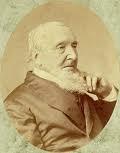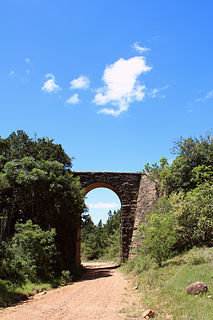History
The village was founded by Lieutenant Richard Daniell, R.N.. He was leader of the Daniell party of the British 1820 Settlers to the Eastern Cape which came to South Africa on the ship the Duke of Marlborough . He named the village after his home town of Sidbury, Devonshire. [3]
He provided land and funds for the building of a church in the village, the church (named St Peter's after the church in Sidbury, Devonshire) was built in 1841 and was one of the first ten Anglican churches in South Africa. The church predates the establishment of the Diocese of Cape Town. The church is a heritage site recognised by the South African Heritage Resource Agency.
In the 1890s, the community of Sidbury started a cricket club which continues to the present despite its small population. [5]

Albany, South Africa was a district in the Eastern Cape, South Africa. Grahamstown was traditionally the administrative capital, cultural centre and largest town of the Albany district.

Makhanda, commonly known as Grahamstown, is a town of about 70,000 people in the Eastern Cape province of South Africa. It is situated about 110 kilometres (70 mi) northeast of Gqeberha and 130 kilometres (80 mi) southwest of East London. Makhanda is the largest town in the Makana Local Municipality, and the seat of the municipal council. It also hosts Rhodes University, the Eastern Cape Division of the High Court, the South African Library for the Blind (SALB), a diocese of the Anglican Church of Southern Africa, and 6 South African Infantry Battalion.

St. Andrew's College is an Anglican high school for boys located in Makhanda, Eastern Cape province of South Africa. It was founded in 1855 by the Right Reverend John Armstrong, the first Bishop of Grahamstown. It is a semi boarding school, with a number of day boys. St. Andrew's College caters to 480 pupils from around the globe. The school is also a member of the G20 Schools group and closely associated with its brother school, St. Andrew's Preparatory School, and its sister school the Diocesan School for Girls.

Henry Hare Dugmore (1810–1896) was an English missionary, writer and translator. He was born in England to Isaac and Maria Dugmore and baptised in Birmingham on 5 June 1810. The family emigrated when his father was financially ruined after being forced to pay the debts of a relative for whom he had stood surety. The Dugmore family sailed to South Africa on the vessel Sir George Osborn in 1820 as part of the Gardner party of 1820 Settlers.

The 1820 Settlers were several groups of British colonists from England,Ireland,Scotland and Wales. settled by the government of the United Kingdom and the Cape Colony authorities in the Eastern Cape of South Africa in 1820.

Bathurst is about 12 kilometres (7.5 mi) inland from Port Alfred, on the R67 road, in the Eastern Cape province of South Africa, and is named after Henry Bathurst, 3rd Earl Bathurst, Secretary of State for the Colonies by Sir Rufane Donkin. Its chief claim to fame is that it was the early administrative centre established by the British Government for the 1820 British Settlers who were sent to the district as a buffer between the Cape Colony and the Xhosa pastoralists who were migrating southwards and westwards along the coast. Bathurst is now part of the Ndlambe Local Municipality in the Sarah Baartman District Municipality of the Eastern Cape.

Richard Gush (1789–1858) was an 1820 Settler. Originally from Beer, a village in Devon, England, he settled in Salem, near Grahamstown in the Eastern Cape Province of South Africa. His parents were Thomas and Mary Gush and his grandparents were James and Agnes Gush all of whom lived in Devon.

Kingswood College is a private, Methodist co-educational school in Makhanda, Eastern Cape, South Africa attended by boarding and day scholars, and a member of the Independent Schools Association of South Africa. The school leavers write the matriculation examinations set by the Independent Examinations Board (IEB).

The Diocese of Cape Town is a diocese of the Anglican Church of Southern Africa (ACSA) which presently covers central Cape Town, some of its suburbs and the island of Tristan da Cunha, though in the past it has covered a much larger territory. The Ordinary of the diocese is Archbishop of Cape Town and ex officio Primate and Metropolitan of the ACSA. His seat is St. George's Cathedral in Cape Town.

The 1820 Settlers National Monument, which honours the contribution to South African society made by the British 1820 Settlers, overlooks Makhanda in the Eastern Cape. It commemorates the Anglo-African folk, as well as the English language as much as the Settlers themselves. The building was designed by John Sturrock, Sturrock was inspired by the work of Louis Kahn.

The Cathedral of St Michael and St George is the home of the Anglican Diocese of Grahamstown in Makhanda in the Eastern Cape Province of South Africa. It is the episcopal seat of the Bishop of Grahamstown. The cathedral is located on Church Square and has the tallest spire in South Africa 176 feet (54 m). The cathedral is dedicated to St Michael and St George and celebrates its patronal festival on the Sunday closest to Michaelmas.

Sidbury is a large village north of Sidmouth on the A375 road in Devon, England. In 2011 the built-up area had a population of 457. In 1951 the civil parish had a population of 2507.

The Diocese of Grahamstown is a diocese of the Anglican Church of Southern Africa. It is centred on the historic city of Makhanda in the Eastern Cape Province of South Africa. The diocese extends to East London, in the east and Port Alfred to the south.
The Diocese of Mthatha is a diocese of the Anglican Church of Southern Africa in the Eastern Cape province of South Africa. Before 2006 it was known as the Diocese of St John's, and earlier still as that of Kaffraria. The diocese currently has 96 parishes.

St George's Cathedral is the Anglican cathedral in Cape Town, South Africa, and the seat of the Archbishop of Cape Town. St. George's Cathedral is both the metropolitical church of the Anglican Church of Southern Africa and a congregation in the Diocese of Cape Town.

Robert Godlonton (1794–1884) was an influential politician of the Cape Colony.

Mike Berning was a South-African Librarian, author, and bell ringer. He is best known as a Head of Cory Library (1965) and Deputy University Librarian.

Guybon Damant Atherstone M. Inst. C.E. AKC, South African railway engineer.
Ivan Mitford-Barberton (1896–1976) was a sculptor, writer and authority on heraldry.

















